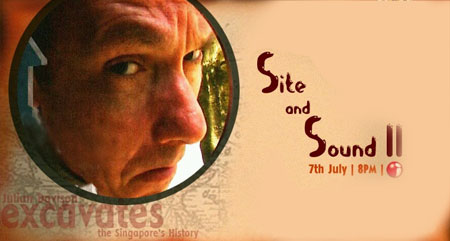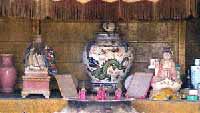"Illegal excavation on Pulau Ubin threatening birds and marine life"
Source: The Straits Times, September 16, 1991
Report by: David Miller
Taken from:
recyclingpoint.com
THE illegal excavation of soil on several plots of land in Pulau Ubin has destroyed the nesting grounds of some local birds and is threatening marine life as well.
Dr Ho Hua Chew, chairman of the Conservation Committee of the Malayan Nature Society (Singapore Branch), said that part of a hill on one of the three plots which was illegally excavated was a haven for a rare species of bird - the
red jungle fowl.
The endangered birds - ancestors of the domestic fowl - are protected under local law. Although native to this region, they can only be found in Singapore on Pulau Ubin.
Bird lovers fear that the destruction of its natural habitat would have serious consequences for the future of the colony.
The area is also a sanctuary for other birds such as the green imperial pigeon, the ruby-cheeked sunbird, and the magpie robin.
A Straits Times check at the island last week found that on the plots which cover a total area of 16 hectares on the island's northern shores, excavation has laid waste huge stretches of land.
There are large hollowed-out depressions there - 3-metre-deep in some places - a silent indication of the vast quantities of soil which had been illicitly removed.
And with the natural protective vegetation cleared away, erosion has set in.
The run-off by rain water across the now barren landscape has cut ugly gullies in the soft soil and turned the nearby coastal waters muddy brown.
This case came to light last Monday when the Urban Redevelopment Authority (URA) took court action against four landowners for marring the island's landscape by illegally excavating and removing soil and using the land for unauthorized storage of property like disused trucks.
One of the owners said the soil was used for "industrial purposes" but declined to give further details. The other three could not be contacted. Villagers on the island believe the soil was taken away in barges to another Island. But most residents were unaware that the excavation was illegal.
According to the URA, some of the of fences went as far back as 1966. The owners and operators of the land had ignored the URA’s order to restore the plots to their original condition and this led to the court action.
The URA has again ordered the owners to refill and returf the land to its original condition. Details of how this will be done are expected to be worked out soon between the URA and the owners.
The maximum penalty for the offence is a fine of $3,000 or a jail term of up to three months, or both.
Meanwhile, conservationists are worried that If left unchecked, the rate of erosion could spell disaster for local marine life.
Associate Professor Chia Lin Sien of the Geography Department at the National University of Singapore said the excavation and the washing of soil to remove the finer particles which would render It suitable for Industrial use, will adversely affect the marine eco-system in the surrounding waters.
He said the erosion would lead to a silting of the sea water, which may in turn hinder the growth of Muatic plants like the sea grass.
On its impact on the food chain of the marine eco-system, he said aquatic plants provide both food and shelter for small marine animals and fish, which in turn support larger marine life forms.
One initial reaction to the gradual silting of the waters around Pulau Ubin would be the disappearance of fish which would move to more attractive feeding grounds.
Perhaps even more worrying is that the layer of silt would eventually settle on the sea bed, causing distress to marine creatures such as sea worms, coral and crustaceans.
Others which could be put at risk by unchecked erosion are the few families of sea cows or dugongs which inhabit the surrounding waters.
These lovable and virtually defenseless mammals thrive or sea grass which would not be able to grow in muddy waters.
Conservationists said that while remedial action in refilling the excavated land and replanting it may help contain the problem, it could take many years before nature’s balance is restored.
Said Dr Ho: "As it stands now, It could be difficult for the natural vegetation to recolonialise the area as nutrients in the soil have been depleted."
Prof Chia said it would be an expensive operation to restore the land to Its original condition as soil would have to be brought In to refill the excavated parts.
Even then he cautioned that care should be taken to ensure that replanting is done selectively, using only the natural trees and shrubs native to the region.
Pulau Ubin, which is a brisk six-minute boat-ride from Changi Point, has largely been preserved in Its natural state to promote outdoor activities like trekking, rock climbing and bird-watching.
It also houses the Outward Bound School.















 According to the
According to the  Mr Lim Kia relocated from the island to Bedok North 26 years ago. But every year, the sprightly retiree returns to Pulau Ubin on the 15th and 16th of the seventh month in the Chinese lunar calendar when the island celebrates the Hungry Ghost Festival. Said Mr Lim, 59, in Mandarin: 'I was born and brought up here. Most of my friends are still living here. So this festival is a good time for us to gather and catch up with one another.'
Mr Lim Kia relocated from the island to Bedok North 26 years ago. But every year, the sprightly retiree returns to Pulau Ubin on the 15th and 16th of the seventh month in the Chinese lunar calendar when the island celebrates the Hungry Ghost Festival. Said Mr Lim, 59, in Mandarin: 'I was born and brought up here. Most of my friends are still living here. So this festival is a good time for us to gather and catch up with one another.'
 Mr Lim Kia turned out to be a vociferous auctioneer, and kept shouting 'Gah gah!' (be bold in Hokkien) to the crowd. Standing around him were the bidders - mostly middle-aged men - clutching beer bottles and dragging their slippers. But they put up a bidding war no less exciting than what is seen at mainland auctions. The lack of getai and dinner didn't stop the 100-strong crowd from enjoying themselves. Some mainland visitors stayed till the auction and opera ended at 11pm before heading home.
Mr Lim Kia turned out to be a vociferous auctioneer, and kept shouting 'Gah gah!' (be bold in Hokkien) to the crowd. Standing around him were the bidders - mostly middle-aged men - clutching beer bottles and dragging their slippers. But they put up a bidding war no less exciting than what is seen at mainland auctions. The lack of getai and dinner didn't stop the 100-strong crowd from enjoying themselves. Some mainland visitors stayed till the auction and opera ended at 11pm before heading home.
 THEY used to be petrified of him. But now, Mr Lim Kia and Ubin resident Kek Koon Hai regard their former teacher, Mr Kek Yak Kwai, 67, fondly. They all help out together at the Hungry Ghost festival celebration every year. The grey-haired but fit-looking man was their Chinese teacher at Min Jiang Primary School on Ubin, where he taught for 27 years. Said the younger Mr Kek, 47, a kitchen helper: 'He once caned me on my buttocks for something I did wrong. I can still remember the pain!' His former teacher, who is not related to him, smiled. He was pleased to see many of his former students again on the island. I'm also glad to see them all grown-up and doing well,' said Mr Kek, who moved to Tampines around 20 years ago. 'Some of them are even grandfathers now!'
THEY used to be petrified of him. But now, Mr Lim Kia and Ubin resident Kek Koon Hai regard their former teacher, Mr Kek Yak Kwai, 67, fondly. They all help out together at the Hungry Ghost festival celebration every year. The grey-haired but fit-looking man was their Chinese teacher at Min Jiang Primary School on Ubin, where he taught for 27 years. Said the younger Mr Kek, 47, a kitchen helper: 'He once caned me on my buttocks for something I did wrong. I can still remember the pain!' His former teacher, who is not related to him, smiled. He was pleased to see many of his former students again on the island. I'm also glad to see them all grown-up and doing well,' said Mr Kek, who moved to Tampines around 20 years ago. 'Some of them are even grandfathers now!'